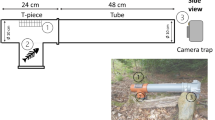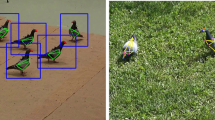Abstract
One of the main concerns when collecting data is the bias stemming from the researchers’ expertise and training. The precision and accuracy of the data being collected can vary depending on the focus, concentration, mood, and experience of a researcher, and this can generate errors in data collection that can influence the results. We present a software for counting leaf-cutting ants that tracks the number of ants on previously recorded videos. The software was developed in the Python language and uses an image processing library called OpenCV (Open Source Computer Vision). It is based on a low-resolution video (640 × 480 pixels) taken with a camera mounted on a tripod and orientated perpendicularly to the ground. This open access program uses the movement of ants to identify their position and track them. It counts the number of ants that pass through a given point in two directions with respect to the nest entrance: incoming and outgoing. Comparisons between AntCounter and conventional methods used to count ants show that the program has higher accuracy than traditional counting in real time while reducing data collection time. We also report the error in the data collected by AntCounter. Using AntCounter the researcher reduces both the time of data collection in the field and the time to process data. It is also possible to improve the sampling effort (e.g., increase the number of samples, the number of experimental units), and measure the ants for longer periods of time, and at lower prices.



Similar content being viewed by others
References
Atmar J, Pooler J, Webb F, et al. (1973) Construction of a device to identify and count insects automatically. Environ Entomol 2:713–716
Branson K, Robie A, Bender J (2009) High-throughput ethomics in large groups of drosophila. Nat Methods 6:451–457. doi:10.1038/NMETH.1328
Cherrett JM (1968) The foraging behaviour of Atta cephalotes L. (hymenoptera: Formicidae). J Anim Ecol 37:387–403
Cho J, Choi J, Qiao M, et al (2007) Automatic identification of whiteflies, aphids and thrips in greenhouse based on image analysis.
Costa AN, Vasconcelos HL, Vieira-Neto EHM, Bruna EM (2008) Do herbivores exert top-down effects in Neotropical savannas? Estimates of biomass consumption by leaf-cutter ants. J Veg Sci 19:849–854. doi:10.3170/2008-8-18461
Dawson CW, Abrahart RJ, See LM (2010) HydroTest: further development of a web resource for the standardised assessment of hydrological models. Environ Model Softw 25:1481–1482
Domínguez E, Dawson CW, Ramirez A, Abrahart RJ (2010) The search for orthogonal hydrological modelling metrics: a case study of 20 monitoring stations in Colombia. J hydroinformatics 13:429–442
Ebert B (2013) WWRP/WGNE Joint Working Group on Forecast Verification Research. http://www.cawcr.gov.au/projects/verification/.
Farji-Brener AG (2005) The effect of abandoned leaf-cutting ant nests on plant assemblage composition in a tropical rainforest of Costa Rica. Ecoscience 12:554–560
Farji-Brener AG, Illes A (2000) Do leaf-cutting ant nests make “bottom -up” gaps in neotropical rain forests? A critical review of the evidence. Ecol Lett 3:219–227. doi:10.1046/j.1461-0248.2000.00134.x
Farji-Brener AG, Silva JF (1996) Leaf-cutter ants (Atta laevigata) aid to the establishment success of Tapirira veluntinifolia (Anacardiaceae) seedlings in a parkland savanna. J Trop Ecol 12:163–168
Farji-Brener AG, Werenkraut V (2014) A meta-analysis of leaf-cutting ant nest effects on soil fertility and plant performance. Ecol Entomol:1–9. doi:10.1111/een.12169
Green M (1999) The Appropriate and Effective Use of Security Technologies in U.S. school. Online Book, Washington D.C.
Herz H, Beyschlag W, Hölldobler B (2007a) Herbivory rate of leaf-cutting ants in a tropical moist forest in Panama at the population and ecosystem scales. Biotropica 39:482–488. doi:10.1111/j.1744-7429.2007.00284.x
Herz H, Beyschlag W, Hölldobler B (2007b) Assessing herbivory rates of leaf-cutting Ant (Atta colombica) colonies through short-term refuse deposition counts. Biotropica 39:476–481. doi:10.1111/j.1744-7429.2007.00283.x
Ho T, Basu M, Law M (2006) Data complexity in pattern recognition.
Hodgson ES (1955) An ecological study of the behavior of the leaf-cutting ant Atta cephalotes. Ecology 36:293–304
Hölldobler B, Wilson EO (1990) The ants. Harvard University Press, Cambridge, Mass
Kooij PW, Liberti J, Giampoudakis K, et al. (2014) Differences in forage-acquisition and fungal enzyme activity contribute to niche segregation in Panamanian leaf-cutting ants. PLoS One 9:e94284. doi:10.1371/journal.pone.0094284
Leal IR, Oliveira PS (1998) Interactions between fungus-growing ants (Attini), fruits and seeds in cerrado vegetation in Southeast Brazil. Biotropica 30:170–178. doi:10.1111/j.1744-7429.1998.tb00052.x
Leal IR, Oliveira PS (2000) Foraging ecology of attine ants in a Neotropical savanna: seasonal use of fungal substrate in the cerrado vegetation of Brazil. Insect Soc 47:376–382. doi:10.1007/PL00001734
Leal N, Leal E, Bedoya JWB (2010) Sistemas de monitoreo de tránsito vehicular basados en técnicas de segmentación de imágenes. Av en Sist e Informática 7:75–86
Leal IR, Wirth R, Tabarelli M (2014) The Multiple Impacts of Leaf-Cutting Ants and Their Novel Ecological Role in Human-Modified Neotropical Forests. Biotropica:1–13. doi:10.1111/btp.12126
Lewis T, Pollard GV, Dibley GC (1974) Rhythmic foraging in the leaf-cutting ant Atta cephalotes (L.)(Formicidae: Attini). J Anim Ecol 43:129–141
Lochmatter T, Roduit P, Cianci C, et al (2008) Swistrack-a flexible open source tracking software for multi-agent systems. Intell Robot Syst 2008 IROS 2008 IEEE/RSJ Int Conf 4004–4010.
Mersch DP, Crespi A, Keller L (2013) Tracking individuals shows spatial fidelity is a key regulator of ant social organization. Science 340:1090–1093. doi:10.1126/science.1234316
Moll K, Roces F, Federle W (2010) Foraging grass-cutting ants (Atta vollenweideri) maintain stability by balancing their loads with controlled head movements. J Comp Physiol A Neuroethol 196:471–480. doi:10.1007/s00359-010-0535-3
Moutinho P, Nepstad DC, Davidson EA (2003) Influence of leaf-cutting ant nests on secondary forest growth and soil properties in Amazonia. Ecology 84:1265–1276. doi:10.1890/0012-9658(2003)084[1265:IOLANO]2.0.CO;2
Noldus LP, Spink AJ, Tegelenbosch RA (2001) EthoVision: a versatile video tracking system for automation of behavioral experiments. Behav Res Methods Instrum Comput 33:398–414
Razin N, Eckmann J, Feinerman O (2013) Desert ants achieve reliable recruitment across noisy interactions.
Rico Gray V, Oliveira PS (2007) The ecology and evolution of ant-plant interactions. University of Chicago Press, Chicago
Robinson EJH, Richardson TO, Sendova-Franks AB, et al. (2009) Radio tagging reveals the roles of corpulence, experience and social information in ant decision making. Behav Ecol Sociobiol 63:627–636. doi:10.1007/s00265-008-0696-z
Shen M, Szyszka P, Deussen O, et al. (2015) Automated tracking and analysis of behavior in restrained insects. J Neurosci Methods 239:194–205. doi:10.1016/j.jneumeth.2014.10.021
Silva PSD, Leal IR, Wirth R, et al. (2012) Leaf-cutting ants alter seedling assemblages across second-growth stands of Brazilian Atlantic forest. J Trop Ecol 28:361–368
Traniello JFA (1989) Foraging strategies of ants. Annu Rev Entomol 34:191–210. doi:10.1146/annurev.en.34.010189.001203
Urbas P, Araújo MV Jr, Leal IR, Wirth R (2007) Cutting more from cut forests: edge effects on foraging and herbivory of leaf-cutting ants in Brazil. Biotropica 39:489–495. doi:10.1111/j.1744-7429.2007.00285.x
Varón EH (2006) Distribution and foraging by the leaf-cutting ant, Atta cephalotes L., in coffee plantations with different types of management and landscape contexts, and alternatives to insecticides for its control. Doctor of Philosophy Dissertation, University of Idaho, xv + 130 p.
Vasconcelos HL, Cherrett JM (1997) Leaf-cutting ants and early forest regeneration in Central Amazonia: effects of herbivory on tree seedling establishment. J Trop Ecol 13:357–370
Vasconcelos HL, Fowler HG (1990) Foraging and fungal substrate selection by leaf-cutting ants. In: Vander Meer RK, Jaffe K, Cedeno A (eds) Applied myrmecology, a world perspective, vol 741. Westview Press, Boulder, pp. 410–419
Weber NA (1972) The Attines: the fungus-culturing ants. Am Sci 60:448–456
Wirth R, Beyschlag W, Ryel RJ, Holldobler B (1997) Annual foraging of the leaf-cutting ant Atta Colombica in a semideciduous rain forest in Panama. J Trop Ecol 13:741–757
Yackulic CB, Lewis OT (2007) Temporal variation in foraging activity and efficiency and the role of hitchhiking behaviour in the leaf-cutting ant, Atta cephalotes. Entomol Exp Appl 125:125–134. doi:10.1111/j.1570-7458.2007.00606.x
Zayas I, Flinn P (1998) Detection of insects in bulk wheat samples with machine vision. Trans ASAE-American Soc Agric Eng 41:883–888
Acknowledgments
The authors wish to thank the systems engineer, Andrés Morales, who advised us on some aspects of programming with Python. This work was supported by a scholarship to the junior author by COLCIENCIAS “Convocatoria Doctorados en Colombia 511 del año 2010” and by Pontificia Universidad Javeriana, Departamento de Ecología y Territorio, Laboratorio de Ecología Evolutiva y Conservación. Additionally we wish to thank to the three anonymous reviewers who provided constructive suggestions that greatly improved the manuscript.
Author information
Authors and Affiliations
Corresponding author
Rights and permissions
About this article
Cite this article
Bustamante, S., Amarillo-Suárez, A.R. AntCounter Software: Counting Leaf-Cutting Ants Was never so Precise, fast and Easy. J Insect Behav 29, 262–272 (2016). https://doi.org/10.1007/s10905-016-9558-0
Revised:
Accepted:
Published:
Issue Date:
DOI: https://doi.org/10.1007/s10905-016-9558-0




